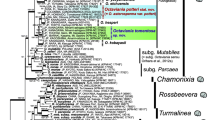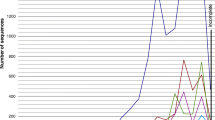Abstract
The genus Tulasnella comprises important orchid mycobionts. Molecular phylogenetic studies on nrITS-5.8S sequences of Tulasnella species previously isolated from mycorrhizas of epiphytic orchids from a tropical Andean forest showed genomic variability among clones which was difficult to interpret as intra- or interspecific variations or to correlate with described Tulasnella species. To improve this situation, we collected basidiomata of Tulasnella in an Andean forest, studied part of the sequences of fungal ribosomal genes and correlated molecular data with the morphology of the specimens. Within five basidiomata displaying slight morphological variability, we found inter-specimen nrITS1-5.8S-ITS2 variability corresponding to proportional differences of less than 1% except for one clone with 5.1% divergence. Results indicate that the slightly variable basidiomata should be considered as one species, which is morphologically tentatively assigned to the Tulasnella pruinosa complex. However, comparison of nrITS1-5.8S-ITS2 sequences, including sequences of T. pruinosa from other origins, indicate that Tulasnella sp. is only distantly related to the T. pruinosa specimens included in the analyses. Sequences of all morphologically similar and taxonomically well-identified species are required to decide whether the basidiomata analyzed in the present study represent a new species. The new sequences are rather similar to sequences obtained previously from mycorrhizae of epiphytic orchids of the same area indicating mycorrhizal potential of this fungus.




Similar content being viewed by others
References
Beck E, Makeschin F, Haubrich F, Richter M, Bendix J, Valarezo C (2008) The ecosystem (Reserva Biológica San Francisco). In: Beck E, Bendix J, Kottke I, Makeschin F, Mosandl R (eds) Gradients in a tropical mountain ecosystem of Ecuador. Ecological Studies, 198. Springer, Berlin, pp 1–14
Bidartondo MI, Bruns TD, Weiß M, Sergio S, Read DJ (2003) Specialized cheating of the ectomycorrhizal symbiosis by an epiparasitic liverwort. Proc R Soc Lond B 270:835–842
Bougoure JJ, Bougoure DS, Cairney WG, Dearnaley DW (2005) ITS-RFLP and sequence analysis of endophytes from Acianthus, Caladenia and Pterostylis (Orchidaceae) in southeastern Queensland. Mycol Res 109:452–460
Bourdot H, Galzin A (1909) Hymenomycetes de France. I Heterobasidiés. Bull Soc Mycol Fr 25:15–36
Bourdot H, Galzin A (1928) Hymenomycetes de France. Heterobasidiés. Cramer J (ed) III Tulasnellaceae, vol 23. Biblioth Mycol. (reprint, 1969)
Cullings KW (1994) Molecular phylogeny of the Monotropoideae (Ericaceae) with a note on the placement of the Pyroloideae. J Evol Biol 7:501–516
DeSalle R, Egan MG, Sidall M (2005) The unholy trinity: taxonomy, species delimitation and DNA barcoding. Philos Trans R Soc Lond B 360:1905–1916
Felsenstein J (1985) Confidence limits on phylogenies: an approach using the bootstrap. Evolution 39:783–791
Gascuel O (1997) BIONJ: An improved version of the NJ algorithm based on a simple model of sequence data. Mol Biol Evol 14:685–695
Greslebin GA, Rajchenberg M (2001) The genus Tulasnella with a new species in the Patagonian Andes forests of Argentina. Mycol Res 105:1149–1151
Huelsenbeck JP, Ronquist FR (2001) MrBayes: Bayesian inference of phylogenetic trees. Bioinformatics 17:754–755
Iotti M, Zambonelli A (2006) A quick and precise technique for identifying ectomycorrhizas by PCR. Mycol Res 110:60–65
Jülich W, Jülich U (1976) A contribution towards a revision of the genus Tulasnella. Persoonia 2:49–64
Katoh K, Misawa K, Kuma K, Miyata T (2002) MAFFT: a novel method for rapid multiple sequence alignment based on fast Fourier transformation. Nucleic Acids Res 30:3059–3066
Kirk PM, Cannon PM, David JC, Stalpers JA (2008) Ainsworth & Bisby’s Dictionary of the Fungi, 10th edn. CAB International, Wallingford
Kristiansen KA, Taylor DL, Kjoller HN, Rasmussen N, Rosendahl S (2001) Identification of mycorrhizal fungi from single pelotons of Dactylorhiza majalis (Orchidaceae) using single-strand conformation polymorphism and mitochondrial ribosomal large subunit DNA sequences. Mol Ecol 10:2089–2093
Kristiansen KA, Freudenstein JV, Rasmussen FN, Rasmussen HN (2004) Molecular identification of mycorrhizal fungi in Neuwiedia veratrifolia (Orchidaceae). Mol Phylogenet Evol 33:251–258
Krüger M, Stockinger H, Krüger C, Schüßler A (2009) DNA-based detection of Glomeromycota: one PCR primer set for all arbuscular mycorrhizal fungi. New Phytol 183:212–223
Lee MSY (2001) Unalignable sequences and molecular evolution. Trends Ecol Evol 16:681–685
Lee C, Grasso C, Sharlow M (2002) Multiple sequence alignment using partial order graphs. Bioinformatics 18:452–464
Ma M, Tan TK, Wong SM (2003) Identification and molecular phylogeny of Epulorhiza isolates from tropical orchids. Mycol Res 107:1041–1049
McCormick MK, Whigham DF, O’Neill J (2004) Mycorrhizal diversity in photosynthetic terrestrial orchids. New Phytol 163:425–438
McCormick MK, Whigham DF, Sloan D, O’Malley K, Hodkinson B (2006) Orchid-fungus fidelity: a marriage meant to last? Ecology 87:903–911
Nilsson RH, Kristiansson E, Ryberg M, Hallenberg N, Larsson K-H (2008) Intraspecific ITS variability in the Kingdom Fungi as expressed in the internal sequence databases and its implications for molecular species identification. Evol Bioinform 4:193–201
Olive LS (1957) Tulasnellaceae of Tahiti. A revision of the family. Mycol 49:663–679
Pereira OL, Rollemberg CL, Borges AC, Matsuoka K, Kasuya MCM (2003) Epulorhiza epiphytica sp. nov. isolated from mycorrhizal roots of epiphytic orchids in Brazil. Mycoscience 44:153–155
Pereira OL, Kasuya MCM, Borges AC, Fernandes de Araújo E (2005) Morphological and molecular characterization of mycorrhizal fungi isolated from neotropical orchids in Brazil. Can J Bot 83:54–65
Roberts P (1992) Spiral-spored Tulasnella species from Devon and the New Forest. Mycol Res 96:233–236
Roberts P (1993a) The genus Tulasnella in Norway. Windahlia 20:67–73
Roberts P (1993b) Allantoid-spored Tulasnella species from Devon. Mycol Res 97:213–220
Roberts P (1994a) Long-spored Tulasnella species from Devon, with additional notes on allantoid-spored species. Mycol Res 98:1235–1244
Roberts P (1994b) Globose and ellipsoid-spored Tulasnella species from Devon and Surrey, with a key to the genus in Europe. Mycol Res 98:1431–1452
Roberts P (1999) Rhizoctonia-forming Fungi: a taxonomic guide. Royal Botanic Gardens, Kew
Rogers DP (1932) A cytological study of Tulasnella. Bot Gaz 94:86–105
Rogers DP (1933) A taxonomic review of the Tulasnellaceae. Ann Mycol 31:181–203
Ryberg M, Nilsson RH, Kristiansson E, Töpel M, Jacobsson S, Larsson E (2008) Mining metadata from unidentified ITS sequences in GenBank: a case study in Inocybe (Basidiomycota). BMC Evol Biol 8:50–64
Sharon M, Kuninaga S, Hyacumachi M, Naito S, Sneh B (2008) Classification of Rhizoctonia spp. using rDNA-ITS sequence analysis supports the genetic basis of the classical anastomosis grouping. Mycoscience 49:93–114
Shefferson RP, Weiß M, Kull T, Taylor DL (2005) High specificity generally characterizes mycorrhizal association in rare lady’s slipper orchids, genus Cypripedium. Mol Ecol 14:613–626
Shefferson RP, Taylor DL, Weiß M, Garnica S, McCormick MK, Adams S, Gray HM, McFarland JW, Kull T, Tali K, Yukawa T, Kawahara T, Miyoshi K, Lee Y (2007) The evolutionary history of mycorrhizal specificity among lady’s slipper orchids. Evolution 61:1380–1390
Shefferson RP, Kull T, Tali K (2008) Mycorrhizal interactions of orchids colonizing Estonian mine tailing hills. Am J Bot 95:156–164
Shimura H, Sadamoto M, Matsuura M, Kawahara T, Naito S, Koda Y (2009) Characterization of mycorrhizal fungi from the threatened Cypripedium macranthos in a northern island of Japan: two phylogenetically distinct fungi associated with the orchid. Mycoscience 19:525–534
Simon UK, Weiß M (2008) Intragenomic variation of fungal ribosomal genes is higher than previously thought. Mol Biol Evol 25:2251–2254
Stamatakis A (2006) RAxML-VI-HPC: Maximum Likelihood-based phylogenetic analyses with thousands of taxa and mixed models. Bioinformatics 22(21):2688–2690
Suárez JP, Weiss M, Abele A, Garnica S, Oberwinkler F, Kottke I (2006) Diverse tulasnelloid fungi form mycorrhizas with epiphytic orchids in an Andean cloud forest. Mycol Res 110:1257–1270
Swofford DL (2002) PAUP*4.0 phylogenetic analysis using parsimony (*and other methods). Sinauer, Sunderland
Swofford DL, Olsen GJ, Waddell PJ, Hillis DM (1996) Phylogenetic Inference. In: Hillis DM, Moritz C, Mable BK (eds) Molecular systematics. Sinauer, Sunderland, pp 407–514
Taylor DL (1997) The evolution of myco-heterotrophy and specificity in some North American orchids. PhD thesis, University of California at Berkeley, CA
Taylor DL, McCormick MK (2008) Internal transcribed spacer primers and sequences for improved characterization of basidiomycetous orchid mycorrhizas. New Phytol 177:1020–1033
Taylor DL, Bruns TD, Leake JR, Read DJ (2002) Mycorrhizal specificity and function in myco-heterotrophic plants. In: Van der Heijden MGA, Sanders I (eds ) Mycorrhizal ecology. Ecol Stud 157:375-413
Warcup JH (1973) Symbiotic germination of some Australian terrestrial orchids. New Phytol 72:387–392
Warcup JH, Talbot PHB (1967) Perfect states of Rhizoctonias associated with orchids I. New Phytol 66:631–641
Warcup JH, Talbot PHB (1971) Perfect states of Rhizoctonias associated with orchids II. New Phytol 76:35–40
Warcup JH, Talbot PHB (1980) Perfect states of Rhizoctonias associated with orchids III. New Phytol 86:267–272
White TJ, Bruns TD, Lee SB, Taylor JW (1990) Amplification and direct sequencing of fungal ribosomal RNA genes for phylogenetics. In: Innis MA, Gelfand H, Sninsky JS, White TJ (eds) PCR-protocols and applications: a laboratory manual. Academic, San Diego, pp 315–332
Acknowledgement
The research was funded by the Deutsche Forschungsgemeinschaft (DFG RU 816). We thank Markus Göker for valuable advice on molecular phylogeny and Nature and Culture International (NCI) for providing research facilities at RBSF.
Author information
Authors and Affiliations
Corresponding author
Rights and permissions
About this article
Cite this article
Cruz, D., Suárez, J.P., Kottke, I. et al. Defining species in Tulasnella by correlating morphology and nrDNA ITS-5.8S sequence data of basidiomata from a tropical Andean forest. Mycol Progress 10, 229–238 (2011). https://doi.org/10.1007/s11557-010-0692-3
Received:
Accepted:
Published:
Issue Date:
DOI: https://doi.org/10.1007/s11557-010-0692-3




